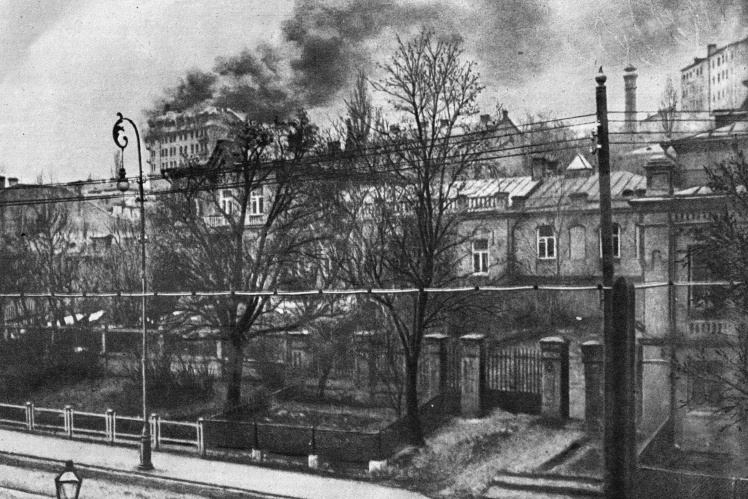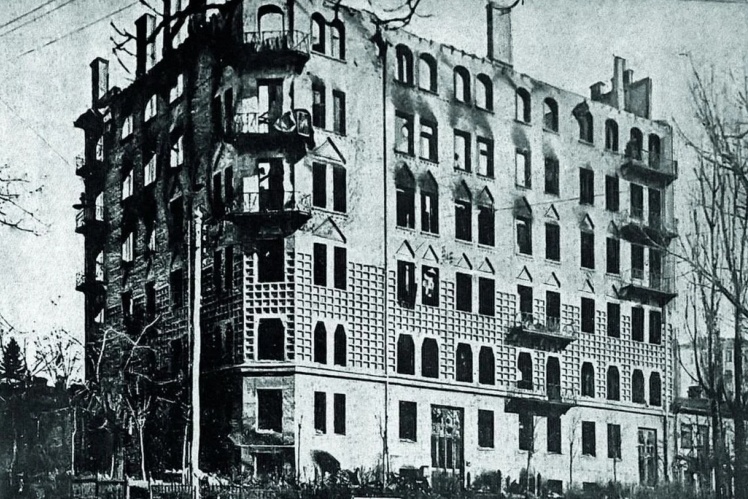In October 1917, the Bolsheviks staged an armed coup, seized power in the then Russian capital, Petrograd, and announced the creation of Soviet Russia. In a few weeks, Ukraineʼs Central Rada adopting the III Universal created the Ukrainian Peopleʼs Republic in Kyiv. After that, relations between the Central Rada and the Bolshevik Council of Peopleʼs Commissars began to deteriorate.
The Bolsheviks openly campaigned for the overthrow of the Ukrainian government and prepared an armed uprising in Kyiv. They planned a coup according to the Petrograd scenario — to block the government quarter, seize bridges, the railway station, the telegraph and other strategic objects. However, the Ukrainian military acted in advance and disarmed the Bolshevik units that were preparing a mutiny in Kyiv and other cities. Disarmed rebels were sent to Russia in wagons under convoy.
Proclamation of the Third Universal on Sofia Square in Kyiv. In the center (from left to right): Symon Petlyura, Volodymyr Vynnychenko, Mykhailo Hrushevskyi, 1917.
Wikimedia
Lenin and his henchmen didnʼt like this. They accused the Central Rada of "unheard-of betrayal of the revolution" and in December 1917 sent an ultimatum to Kyiv. Its essence boiled down to something like this: stop disarming our troops and donʼt prevent them from seizing power in Ukraine at all, and also help fight our enemies in other regions, in particular, in the Don region, where the anti-Bolshevik White movement began to form. The Central Rada, of course, rejected the ultimatum. This was the beginning of the Soviet-Ukrainian war.
Bolshevik troops on Red Square in Moscow, 1917.
Getty Images / «Babel'»
The Bolsheviks invaded Ukraine in the first half of December, 1917. However, at first they declared that their troops would simply use the Ukrainian railway in the Kharkiv region and Donbas to go to the Don. The Kyiv authorities reassured themselves with these statements. The only one who advocated a decisive armed response was Symon Petliura, Minister of War of the Ukrainian Peopleʼs Republic. He directed Ukrainian units to the east to take control of the main railway junctions. The first battles took place, when the Bolsheviks tried to seize the Lozova station in the Kharkiv region.
However, the Prime Minister of the Ukrainian Peopleʼs Republic at that time Volodymyr Vynnychenko believed to the last that a war with the Bolsheviks could be avoided if they were not provoked. Therefore, at the end of December, he obtained the resignation of Petliura and ordered the disbandment of the most combat-ready units in order to demonstrate peaceful intentions and willingness to compromise.
Armored train "Sichovy strelets" of the UNR army in Kyiv, December 1918.
Wikimedia / «Бабель»
But it had the opposite effect. The Bolsheviks were not going to go anywhere from Ukraine. In occupied Kharkiv, they created a puppet Ukrainian Peopleʼs Republic of Soviets. Its representatives quickly declared the Central Rada illegitimate and appealed to Moscow to "bring order to Ukraine." There, of course, they willingly volunteered to "help a brotherly people in an internal conflict."
While the new Minister of War, Vinnychenkoʼs protégé, Mykola Porsh was reorganizing the army of the Ukrainian Peopleʼs Republic, Bolshevik troops gradually occupied Ukrainian territories — Kharkiv, Luhansk, Donetsk, Poltava, Chernihiv, and Katerynoslav regions. Their next goal was Kyiv.
Mikhail Muravyov, a former officer of the tsarist army, headed the Bolshevik "special operation" in Ukraine. He was a careerist, ready to cooperate with any government. After the February Revolution and the overthrow of the monarchy, he became a member of the Socialist-Revolutionary Party and received the position of head of security of the Provisional Government. A few days after the Bolshevik coup, he offered his services to the new government and became commander-in-chief of the troops and head of the defense of Petrograd. And in January 1918, he led a military invasion of Ukraine.
Mikhail Muravyov during his service in the Russian army, 1911-1912.
Wikimedia
According to the recollections of eyewitnesses, Muravyov was marked by painful cruelty. And he was also a staunch opponent of at least some Ukrainian independence. He called its supporters "traitors of the motherland" and mercilessly persecuted them. Already a few days after his troops entered Kharkiv, an armored car with the inscription "Death to Ukrainians" began to drive through the streets of the city.
Eyewitnesses compared the Bolshevik invasion of Ukraine with the Mongol-Tatar invasion. Muravyov really used medieval methods: in Kharkiv the Bolsheviks flayed people, in Poltava they impaled priests, in Katerynoslav they crucified and stoned them, in Odesa they roasted officers in shackles over a slow fire or lowered them into a vat of boiling water. Muravyov gave the cities to his soldiers to plunder, and taxed the inhabitants. He called it a "contribution to the needs of the revolutionary army." He collected 50,000 rubles from Chernihiv, later he will demand 5 million from the people of Kyiv, and in Odesa he will take the richest residents hostage with a demand for a ransom of 10 million.
The place of mass executions of "enemies of the revolution", 1917.
Getty Images / «Babel'»
In such conditions, the Central Rada adopted the IV Universal on January 9, 1918, which proclaimed the independence of the Ukrainian Peopleʼs Republic. A few days later, Vynnychenko resigned from the post of prime minister. But fewer and fewer territories remained under the control of the Ukrainian government. In the middle of January, another Bolshevik rebellion took place in Kyiv, for the suppression of which almost the last combat-ready units of the UNR army had to be sent. So about 500 volunteers, including students and cadets, came forward to meet the advancing Bolshevik units. In the battle near Kruty, they managed to detain Muravyovʼs troops for several days. Only on January 22, 1918, the Bolsheviks captured Brovary and Darnytsia and established themselves on the left bank of the Dnipro.
Bolshevik artillery shelling Ukrainian positions, 1917-1918.
Wikimedia
The next day, January 23, Muravyov gave the order to storm Kyiv. He expected to capture the city almost in a matter of hours. After all, about 1,700 combat-capable Ukrainian soldiers, including volunteers, opposed the 7,000-strong Soviet army with armored trains and armored vehicles. At that time, there were about 430,000 people in Kyiv, among them at least 20,000 former soldiers and officers. However, few of them believed in the UNR, hoping to simply serve under the new government.
Soviet troops broke through to the right bank of the Dnipro on the Darnytsia railway and Chain bridges. However, it was not possible to seize Kyiv by storm. Then Muravyov gave the order to shell the city from the left bank with heavy long-range artillery. Over the next four days, about 15,000 shells were fired at Kyiv. Moreover, the Bolsheviks specifically aimed at the central districts — Pechersk, Lypky, Old Town and the Sofia Square area.
The first Kyiv gymnasium, converted into a hospital, after the Bolshevik shelling in 1918. It was located near the building where the Central Rada was sitting. Now it is the "yellow" building of Taras Shevchenko Kyiv University.
Getty Images / «Babel'»
They hit the building where the Central Rada was sitting — on Volodymyrska Street. They also managed to destroy the house of the chairman of the Central Rada Mykhailo Hrushevskyi on Pankivska Street near the modern Shevchenko Park. "I hit Hrushevskyʼs house, it burned brightly for three days," Muravyov boasted.
The burning house of the Hrushevsky family in Kyiv, view from the railway station, January 25, 1918. The ruins of the house of Mykhailo Hrushevskyʼs family in Kyiv, 1918.
nmiu.org; immh.kyiv.ua
Trying to save the city from destruction, the representatives of the city council went to Darnytsia to negotiate with the Bolsheviks on the terms of stopping the shelling. "I occupied the city, beat palaces and churches... I beat without giving anyone mercy! The council asked for a truce. In response, I ordered to suffocate them with gas," Muravyov recalled. It was with the help of chemical weapons that he captured the bridges over the Dnipro, and then overcame the defensive fortifications of the defenders of Kyiv.
On the night of January 26, 1918, the last units of the UNR army retreated from Kyiv, along with most of the members of the Central Rada, who were evacuated to Zhytomyr. Having captured the city, Muravyov, according to his tradition, gave it to his troops to plunder. Over the next few weeks, the Bolsheviks unleashed real terror in the city, killing an estimated five thousand people. The first to be shot were the former soldiers of the tsarist army who planned to serve time in the city.
Next, Ukrainian politicians, intellectuals and priests were attacked, in particular, Metropolitan Volodymyr of Kyiv and Halytskyi was shot near the walls of the Kyiv-Pechersk Lavra. They also killed random passers-by who had with themselves any document in the Ukrainian language. The occupiers set up headquarters in the Mariinsky Palace, nearby, in the park, was the site of mass shootings. After the murders, the Bolsheviks undressed the shot, looked for valuables, and simply shared the loot among themselves next to the corpses.
Bolshevik soldiers in occupied Kyiv, 1918.
Getty Images / «Babel'»
The scale of the terror shocked even Leninʼs associates and government officials of Soviet Ukraine, who came from Kharkov to legitimize the Bolshevik government in Kyiv. They demanded that Moscow remove Muravyov from Kyiv together with his soldiers. But at first, they almost fell under his hot hand themselves. "Somehow they wanted to shoot me because I showed an ID in Ukrainian. What saved me was that one of the soldiers knew me personally," recalled Mykola Skrypnyk, one of the members of the Soviet Parliament.
Muravyov was transferred to Odesa, where he continued to use the same methods. However, at the end of February, the Bolsheviks had to flee. Under pressure from Germany and its allies, Lenin and his supporters agreed to the Peace of Brest on conditions humiliating for Soviet Russia: the loss of the territories of Ukraine, Finland, and the Baltic states and the payment of billions in reparations.
At the end of April 1918, Muravyov was summoned to Moscow and arrested on charges of "connivance in mass executions, robberies, which led to the fall of Soviet power in Ukraine." However, he was quickly acquitted and sent to command troops in the Urals and Siberia. There, he "made a bet on the wrong ones" — he joined the rebellion of the Left Socialist-Revolutionaries who wanted to depose Lenin and his henchmen, fell into a Bolshevik ambush and died in a shootout in July 1918.
A Bolshevik banner calling for "red terror" in Petrograd, September 1918.
Wikimedia
However, with his brutal methods and especially the massacre in Kyiv, Muravyov set an example to follow. He put into practice Leninʼs theories about terror as a means of establishing the dictatorship of the proletariat. Already in September 1918, a similar practice was legalized by the decree "On Red Terror". Since then, violence, terror and mass repressions have become Moscowʼs main means of asserting Soviet, and later Russian, power in the occupied territories.
Attempts to compromise with the Kremlin lead only to new victims. So that we can continue to remind about this in our historical texts, support "Babel": 🔸 in hryvnia , 🔸 Buy Me a Coffee , 🔸 Patreon , 🔸 PayPal: [email protected].


